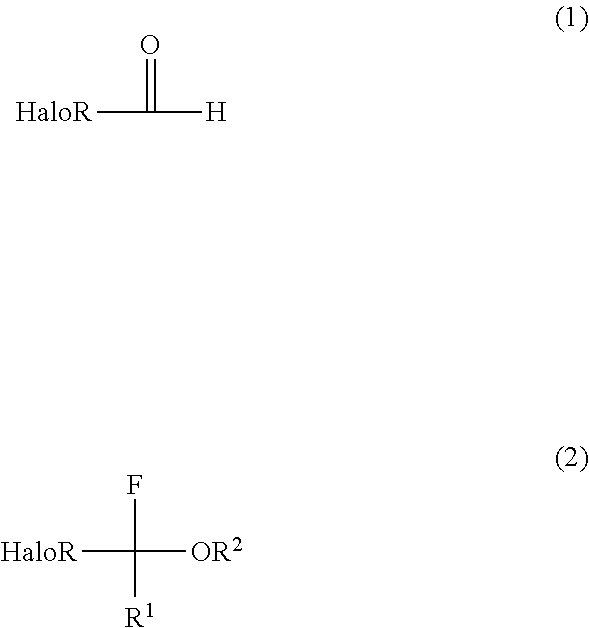Production Method for Halogenated Alpha-Fluoroethers
- Summary
- Abstract
- Description
- Claims
- Application Information
AI Technical Summary
Benefits of technology
Problems solved by technology
Method used
Image
Examples
example 1
[0053]
[0054]In a 100-mL pressure-proof reaction vessel made of stainless steel (SUS) and equipped with a pressure gauge, a stirrer made of polytetrafluoroethylene (PTFE) was placed. Then, 5.0 g (38.4 mmol) of halogenated hemiacetal shown in the above scheme and 3.8 g (192.2 mmol) of hydrogen fluoride were weighed and put into the reaction vessel under ice cooling. After the temperature of the reaction vessel was naturally raised, the resulting liquid was reacted with stirring for 2 hours at room temperature. After the reaction, the internal vessel pressure of 0.15 MPa was released. The thus-obtained reaction liquid was sampled. Anhydrous calcium chloride was added to the liquid sample to remove unreacted hydrogen fluoride therefrom by absorption. After that, the liquid sample was analyzed by 19F-NMR. It was confirmed that halogenated ca-fluoroether shown in the above scheme was obtained with a conversion rate of 29.2% and a selectivity of 93.5%. The by-product rate of acetal shown i...
example 2
[0057]
[0058]In a 100-mL pressure-proof reaction vessel made of stainless steel (SUS) and equipped with a pressure gauge, a stirrer made of polytetrafluoroethylene (PTFE) was placed. Then, 5.0 g (38.4 mmol) of halogenated hemiacetal shown in the above scheme, 3.8 g (192.2 mmol) of hydrogen fluoride and 2.0 g (19.2 mmol) of methyl orthoformate were weighed and put into the reaction vessel under ice cooling. After the temperature of the reaction vessel was naturally raised, the resulting liquid was reacted with stirring for 2 hours at room temperature. After the reaction, the internal vessel pressure of about 0.10 MPa was released. The thus-obtained reaction liquid was analyzed by 19F-NMR. It was confirmed that halogenated α-fluoroether shown in the above scheme was obtained with a conversion rate of 54.0% and a selectivity of 93.4%. The by-product rate of acetal shown in the above scheme was 2.4%.
examples 3 and 4
[0059]
[0060]In each of Examples 3 and 4, the reaction was conducted under the same conditions as in Example 2, except that the amount of the methyl orthoformate added was varied. The results of the Examples 3 and 4 are shown together with the results of Examples 1 and 2 in TABLE 1. The analysis conditions in these examples were the same as those in Example 2.
TABLE 1MethylorthoformateConversion rateSelectivityDimethyl acetalExample(equivalent)(%)(%)(%)1None29.293.53.720.554.093.42.43178.892.04.841.571.585.012.7
[0061]As is seen from the above results, the halogenated ca-fluoroether was obtained with high selectivity in each Example. Further, it was confirmed that the rate of conversion of the starting raw material was improved with the addition of methyl orthoformate.
PUM
| Property | Measurement | Unit |
|---|---|---|
| Fraction | aaaaa | aaaaa |
| Fraction | aaaaa | aaaaa |
| Fraction | aaaaa | aaaaa |
Abstract
Description
Claims
Application Information
 Login to View More
Login to View More - R&D
- Intellectual Property
- Life Sciences
- Materials
- Tech Scout
- Unparalleled Data Quality
- Higher Quality Content
- 60% Fewer Hallucinations
Browse by: Latest US Patents, China's latest patents, Technical Efficacy Thesaurus, Application Domain, Technology Topic, Popular Technical Reports.
© 2025 PatSnap. All rights reserved.Legal|Privacy policy|Modern Slavery Act Transparency Statement|Sitemap|About US| Contact US: help@patsnap.com



